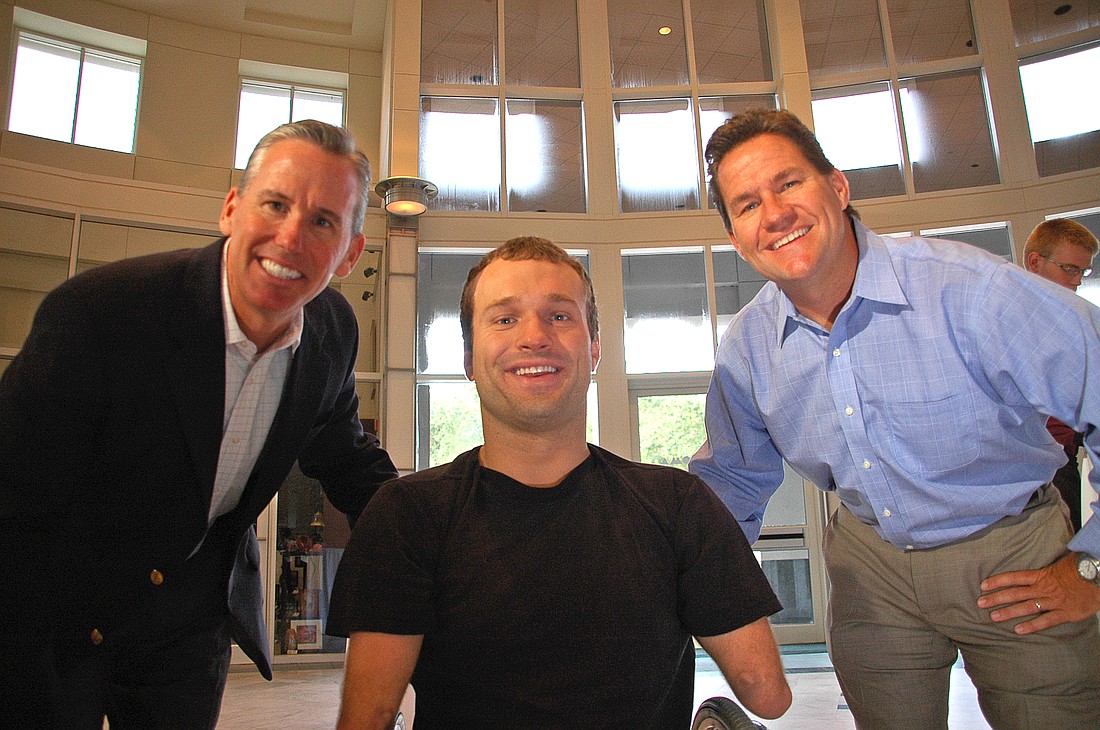- January 1, 2025
-
-
Loading

Loading

To buy your copy of Kyle Maynard’s book, “No Excuses,” visit www.kyle-maynard.com
It started with a handshake near the top of the world. Triathlete Patrick Chapin said he felt like he needed an oxygen mask every other step as he approached 18,500 feet on the treacherous western breach of Tanzania’s Mt. Kilimanjaro. Kyle Maynard had just started his descent an hour or so after doing something no one had done before, reaching the summit walking on his elbows and knees.
They shook hands, far-flung partners in the same journey. For Maynard, it was the grueling finale to an impossible dream come true for a man born with his arms ending at the elbows and legs ending at the knees. For Chapin, the tiny purple flag in Patrick’s backpack still had a long way to go to the rocky peak.
There were eight names printed on the flag Patrick carried, surrounding the word “courage” in big bold letters. For Chapin, and his father, who started the climb with him, this wasn’t a climb for themselves. It was for those who couldn’t reach the summit — Oliver, Austin, Olivia, Ben, Brayden, Ryan, Wavery and Blair.
All of the children named on the flag had met the Chapins, connected with the same terrifying uncertainty. All of them had Sanfilippo syndrome, a rare degenerative illness that breaks down the brain’s ability to function before attacking the body, eventually robbing the victim of both. The oldest survivors of the disease reach their early 20s. Most children affected by it die far younger. Doctors have yet to determine how to stop it.
“It’s catastrophic,” said Patrick, president of the Winter Park Chamber of Commerce. He had seen the disease’s effects firsthand — his brother Roger’s daughter Blair suffers from the same slow decline and lack of answers that characterizes other sufferers of Sanfilippo.
“We felt like we were rats on a wheel,” mother Susan Chapin said of the family’s quest to find a diagnosis for her daughter. “There were so many misdiagnoses.”
Research has been slow in coming as funding has been hard to come by, Patrick said, but a breakthrough in gene therapy from an Ohio researcher is slowly building the hopes of parents of Sanfilippo suffererers. It’s just a question of getting the word out, and the support to come in.
They had their excuses. Patrick, a three-time ironman Triathlete, had never climbed a mountain close to as high as Kilimanjaro. Along with his father, Bruce, he headed for the summit anyway, hoping to raise awareness with each step they took closer to raising that tiny purple flag.
Carrying a soldier home
For Maynard, his journey started six years earlier in an airport in Washington D.C. As he watched two men across a hallway talking to each other, he saw them pointing at him. They knew him, Maynard thought, so he did what came natural. He reached out to shake hands.
Captain Alvin Shell’s hand was burned off, Maynard said. The other soldier, Sgt. Wesley Spaid, also had been badly burned in the same explosion just outside Baghdad. They had shared the same hospital room, the one where they made a pact to commit suicide together. After they saw a video of Maynard’s struggles as a wrestler, losing his first 35 matches before going on to become the No. 12 ranked high-schooler in the nation, they changed their minds.
“That showed me what a real challenge is,” Maynard said. “I held it together while I was talking to them and came back to the hotel that night and cried.”
Six years later, the former champion wrestler was ascending Mt. Kilimanjaro, carrying a small bag of ashes for Pfc. John Corey Johnson, who had died in Afghanistan the year before. He had made a promise to Johnson’s mother when he met her in Arizona.
The climb was grueling, he said, as he forced himself over rock walls and ice fields ascending to the 19,341-foot summit. He took the hard way, seemingly made impossible by the disability he refused to acknowledge. When Maynard thought he couldn’t handle the long way up, team leader Kevin Cherilla asked him if he’d be willing to climb the shorter but far more dangerous western breach. Maynard’s response: “Hell yeah.”
It would take 10 days for Maynard and his team to complete the climb, as Maynard gritted his teeth and repeated a Navy Seal mantra hundreds of thousands of times, he said.
“Not dead. Can’t quit.”
At the peak on Jan. 15, he stood at the top of Africa, and poured Johnson’s ashes onto the rocky summit as tears welled in his eyes.
Unlikely partnership
After watching the video of Maynard’s climb on ESPN, Patrick Chapin only then began to understand the man he’d met briefly nearly four miles up a mountain. That’s when he and his brother Roger formed the idea: ask Maynard to help get the word out about Sanfilippo.
Two months later, Maynard said hello to hundreds of new friends at the Orlando Museum of Art on June 5, as he spoke about living life without excuses.
“There’s probably one major excuse you’re making today that if you changed it, it would change everything,” Maynard told the crowd. “What if you said ‘this excuse dies today?’”
For the Chapins and Maynard, some more excuses died on top of a mountain that frozen morning Jan. 15, as Maynard made good on a promise to give a soldier his last wish, and as the Chapins raised a flag to the top of the world. Now they’re hoping to reach a new goal: finding a cure.
“We have a lot of stumbling blocks ahead of us,” Susan said. “But it doesn’t stop us from hoping.”